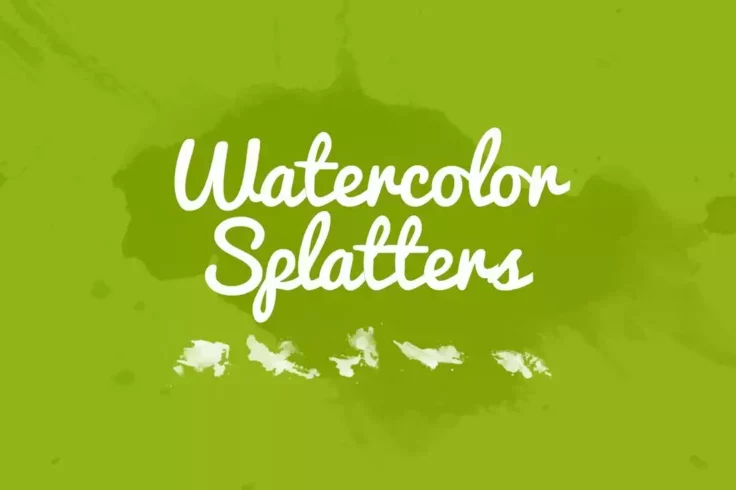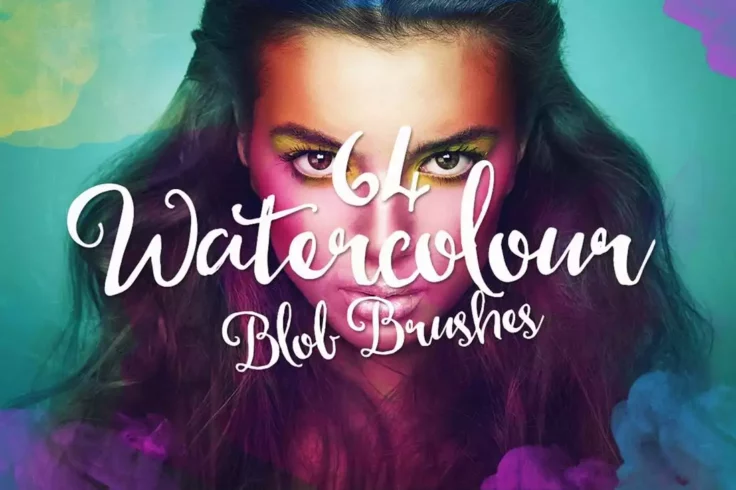40+ Best Watercolor Brushes
Achieve the hand-painted look digitally with our watercolor brushes. Perfect for digital paintings, illustrations, or any design that requires a soft, artistic touch. These brushes mimic the flowing, unpredictable nature of watercolor paint.

Watercolor Design Bundle Brushes & Textures
This is a massive bundle that contains several unique elements you can use to craft your own stylish watercolor designs. The pack includes 169 handcra...

32 Watercolor Splatter Brushes
Watercolor splatter designs are perfect for creating unique typography designs as well as adding texture and vector shapes. This bundle comes with 32 ...

Artistic Studio Watercolor Toolkit
Artistic Studio comes with a massive collection of all sorts of watercolor vectors, brushes, and designs, including 35 Photoshop brushes featuring wat...

50 Photoshop Watercolor Brushes
If you use watercolor designs to add more color to your poster designs and create backgrounds, this bundle will come in handy. It includes 50 Photosho...

50 Procreate Watercolor Brushes
Engage your artistic talent with a comprehensive set of 50 artisanal Procreate watercolour brushes. This diverse collection offers an extensive range ...

Watercolor Magic Vol.1 Photoshop Brushes
With this bundle of watercolor Photoshop brushes, you’ll be able to create true magic. It comes with 25 unique brushes featuring handcrafted des...

64 Photoshop Watercolor Blob Brushes
This bundle of Photoshop brushes includes 64 different watercolor blob designs in 850 to 1200px resolutions. They’re perfect for designing every...

AquaFlow Watercolor Generator
AquaFlow is a complete bundle of watercolor elements that includes lots of different brushes and vectors that you can use to create beautiful watercol...

Watercolor Photoshop Brush Set
These naturalistic watercolor brushes will help you to create any background easily. This brush pack features a huge range of textured strokes that we...

202 Watercolor Brushes for Photoshop
With more than 200 different brushes to choose from, you’ll have plenty of choices to craft various watercolor designs using this pack of Photos...

118 Handcrafted Photoshop Watercolor Brushes
This is a big bundle of Photoshop brushes featuring various styles of watercolor strokes and designs. It includes 118 brushes in .ABR format and in 30...

69 Watercolor Brushes for Photoshop
This brush pack is perfect for adding texture and a personal touch to your designs using watercolor brush strokes. It includes 69 different brushes in...

50 Watercolor Brushes for Photoshop
This bundle includes 50 different watercolor brushes in both dynamic and stamp forms. The brushes are compatible with Photoshop CS3 and higher. In add...

45 Watercolor Photoshop Brushes
Create a unique design and get fun when you paint. You can use these brushes to realize your wildest ideas in design. Brushes are perfect for creating...

Watercolor Texture Photoshop Brushes
These brush textures are high resolution and could be a great addition to any project. You can use them as decorative elements for photos, print templ...

51 Handcrafted Watercolor Brushes
This bundle comes with 51 different Photoshop watercolor brushes featuring designs handcrafted from scratch by professional artists. The brushes are a...

Watercolor Photoshop Brushes Vol.2
Create amazing watercolor artworks and watercolor effects with this set of 23 watercolor brushes included! The brushes are high-quality and resolution...

75 Photoshop Watercolor Brushes Collection
Add lots of beautiful floral elements and illustrations to your designs using this pack of Photoshop brushes. The bundle comes with 60 brushes featuri...

Watercolor Texture Brush 2
The Dans Watercolor Texture Brush for Procreate is the perfect tool for artists seeking to create stunning digital illustrations. These brushes enhanc...

Shimmer Glitter Watercolor Brushes
Dabble in digital impression with a unique touch using Shimmer Glitter Watercolor Brushes, designed specifically for Procreate. It’s ultimately ...

Graphic Beats Photoshop Brushes
Graphic Beats is a collection of Photoshop brushes featuring watercolor inspired brushes in 5 different categories. In this pack, you’ll get acc...

30 Artistic Photoshop Stamp Brushes
A pack of 30 Photoshop stamp brushes that feature various hand-painted designs based on ink designs. This pack is ideal for adding a unique look to yo...

Watercolor Texture Brush 1
Unveiling the new Dansdesign’s Watercolor Texture Brush for Procreate, an innovative addition to the graphic designing world. Created in respons...

Watercolor Aqua Brushes
Add artistic flair to your digital designs with the Waterella Aqua brushset. This top-tier toolkit comprises 23 modern watercolor Procreate brushes. I...

30 Watercolor Texture Photoshop Brushes
Another set of artistic Photoshop stamp brushes featuring watercolor texture designs. This pack is most suitable for designing creative backgrounds an...

30 Gofe Ink Photoshop Brushes
This bundle includes 30 ink-style brushes for Photoshop. Even though these brushes aren’t technically watercolor-based, they closely resemble wa...

Dans Watercolor Brushes for Procreate
Experience a whole new dimension of creativity with Dans Watercolor Brushes for Procreate. Crafted to open up a world of vibrant, digital illustration...

Colter Watercolor Brushes
The Procreate Colter Brush Watercolor set is artistry, conveniently packed for iOS users. The revolutionary creation is strictly compatible with the P...

Modern Watercolor Procreate Brushes
Immerse yourself in the world of digital art with the Modern Watercolor Procreate Brushes. These 22 brushes encompass a multitude of styles suitable f...

Artistic Watercolor Procreate Brushes
Unleash your artistic prowess with the Artistic Watercolor Procreate Brushes, a collection of 22 unique and expertly crafted tools specifically design...

Watercolor & Pencil Procreate Brushes
For all who wish to explore watercolors on a digital platform, this Procreate brushes set will have your artistic senses tingling. This pack offers 14...

Aurora Watercolor Procreate Brushes
Step into artistic bliss with our Aurora Watercolor Procreate Brushes. These brushes, named after the ethereal light of the polar skies, were crafted ...

Water Type Procreate Watercolor Brushes
Water Type is a pack of watercolor brushes designed for crafting various lettering designs. It includes 12 different watercolor brush designs along wi...

Soft Watercolor Procreate Brushes
The Soft Watercolor Procreate Brushes bring the finest watercolor paintings to life in a realistic and quick manner. Designed by a watercolor illustra...

15 Photoshop Watercolor Brushes
A collection of professionally crafted Photoshop watercolor brushes that are perfect for drawing illustrations, creating backgrounds, and adding textu...

Elixir Watercolor Procreate Brushes
This is a complete collection of Procreate resources that include 10 watercolor brushes, 20 stamp brushes, and 3 paper texture canvases. It has everyt...

Realistic Gouache Brushes
Unleash your inner artist with the Realistic Gouache Procreate Brushes. This innovative painting kit for Procreate iPad Brushes will empower you to pr...

Floral Watercolor Photoshop Brushes
This is a set of watercolor high resolution stamp brushes for Photoshop. The set includes leaves, branches, grass, flowers, ribbons, banners, watercol...

Wet Watercolor Brushes
Breathe fresh life into your Procreate masterpieces with our Wet Watercolor Brushes. Known for their authentic, wet realistic watercolor effects, thes...

Aurora Photoshop Watercolor Brushes Collection
Aurora is a collection of unique watercolor Photoshop brushes that feature a set of light brushes you can use to add more texture to design, create pa...

Watercolor Texture Aquarelle Brushes
Art enthusiasts, designers, and digital painters will get excited over Watercolor Texture Aquarelle Brushes. This tool is creatively designed to captu...

Aquarelle Watercolor Brushes
The Aquarelle Watercolor: Procreate Brushes are an artist’s footpath to a breathtakingly picturesque experience. Whether you’re fashioning...
FAQs About Watercolor Brushes
What is unique about watercolor brushes in digital illustration and graphic design?
In digital illustration and graphic design, watercolor brushes bring a distinctive touch to artworks, attempting to emulate the look and feel of traditional watercolor painting. These brushes are designed to mimic the fluidity, transparency, and rich texture of watercolor paint. They can reproduce various effects, such as washes, wet-on-wet, dry brush techniques, and color blending, bringing a sense of organic randomness and spontaneity that is characteristic of physical watercolor painting.
While it's challenging to capture the full complexity of watercolor in a digital format, many of these brushes do an excellent job at providing an authentic-feeling digital watercolor experience. They can be used to create expressive backgrounds, add texture and depth to illustrations, or even create full digital paintings that resemble traditional watercolor works.
How do watercolor brushes interact with digital 'paper' and 'water'?
Watercolor brushes interact with digital 'paper' and 'water' based on the settings and capabilities of the digital art software being used. The brush settings can control how the digital paint is applied to the 'paper', including how much it spreads, how it blends with other colors, and how transparent it is. Some advanced software, like Adobe Fresco, even offer live watercolor brushes that interact in real time with the amount of 'water' and 'paper texture' you select, simulating the way real-world watercolor behaves.
Most digital painting software will allow you to adjust the 'paper' texture, which can greatly affect the look of a watercolor brush. A rougher texture will give the paint more 'tooth' to grip to, creating a grainy look, while a smoother texture will allow the paint to flow more freely. Remember that, just as in traditional painting, the characteristics of the 'paper' and the amount of 'water' can significantly influence the final result.
How can I create my own watercolor brushes for digital illustration?
Creating your own watercolor brushes can be a rewarding process, and it allows you to achieve a more personalized look in your digital art. In most graphic design software, you can create a custom brush by first making a brush shape or pattern, often done by creating a black and white image or using a pre-existing texture. Then, you'll need to adjust various settings related to how the brush applies color, how it reacts to pressure (if you're using a drawing tablet), and how the 'paint' interacts with the 'paper' and 'water'.
Every software has its unique approach and settings, so you may need to experiment and adjust multiple parameters to get the desired effect. Some software, like Adobe Photoshop, even allows you to import textures and patterns to make your brush more realistic. By creating your own brushes, you can develop a unique set of tools tailored to your style and needs.
How do I properly use watercolor brushes in my digital art?
Using watercolor brushes effectively in digital art is a combination of understanding both the software and the principles of traditional watercolor painting. While the software controls the behavior of the brush, knowing how to layer colors, control the amount of 'water', and use different brush sizes and shapes will give your work a more authentic watercolor feel. Many digital artists find that using a drawing tablet, as opposed to a mouse, provides a more natural and intuitive painting experience.
Experimentation is key. Try using different brush sizes, shapes, and textures to see what works best for your particular style. You might also try adjusting the opacity, flow, and blending modes in your software to achieve different effects. Most importantly, study and practice traditional watercolor techniques. Understanding how watercolors behave in the real world can help you make the most of your digital tools.
Are watercolor brushes in graphic design only used for 'painterly' effects?
No, watercolor brushes in graphic design are not only used for creating 'painterly' effects. While they can be used to create digital paintings that look like traditional watercolor art, these brushes also have a wide range of other uses in graphic design. They can be used to add texture and depth to flat digital illustrations, create atmospheric backgrounds, or add a hand-made feel to design elements. The soft edges and organic textures of watercolor can provide a nice contrast to more geometric and precise digital elements.
Moreover, watercolor brushes can be utilized to create stylized text effects, like watercolor lettering, that stand out and catch the eye. They can also be used to apply a wash of color over a photo for a mixed media effect. Overall, the flexibility of watercolor brushes makes them a valuable tool in a graphic designer's toolkit, whether they're creating a fully digital watercolor painting or simply adding some texture to a logo design.